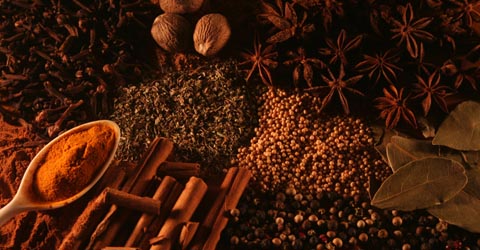Spices as Aromatics

Have you ever smelled something that took you back to a different time and place? Aroma memory evokes powerful responses in humans. Fans of Greek mythology may recall that only the gods were gifted with the knowledge of perfume and fragrance. Now, all of us mere mortals can add them to our cooking!
Taste and aroma are innately linked. Without aroma, the flavour of foods would lack the depth and quality of what we think of as taste. Have you ever wondered why food tastes so bland when you have a cold? It is because your nose can't help you "taste" your food. Without smell we are limited to only the five basic flavours our tongue can detect; sweet, sour, salty, bitter and umami.
Adding Aromatic Spices to the Dukan Diet
On the Dukan Diet you might be in the both the Cruise and Consolidation Phase for an extended period of time, and you don't want to get discouraged and give up just because you get bored with your food choices. You can use spices to keep even the most pedestrian of meals exciting! Part of that process is enticing your taste buds, and your brain, to try new things. Don't just grill the same old chicken; make the whole kitchen smell like a Moroccan market with turmeric and saffron. It's easier than you think!
Here are some different ways to use aromatic spices in your cooking:
- Grinding - Use a spare coffee grinder (note: you are probably not going to want to use it for coffee again), pepper grinder, or small food processor. Be careful as some strong spices such as cloves contain damaging oils which can discolour plastic parts.
- Toasting - Heat a saute pan to medium and add seeds such as cumin, coriander, fennel, poppy or sesame (leave the oily ones till the Consolidation phase). Keep stirring until lightly browned and fragrant oils are released.
- Bouquet Garni - place a small handful of spices in a square of cheesecloth, tie with kitchen twine and drop into soups or stews, and simmer. This is easily removed from the pot before serving. While this is usually done with leafy herbs - especially bay leaf - try garlic/rosemary, sage/thyme, saffron, paprika, or any other combination you can think of.
Comfort Through Aromatherapy
Aromatherapy is not just that wonderful eucalyptus smell we all know and love at the spa; it can also be the comforting aroma of cooking food. The term "aromatherapy" originated in 1937 when French chemist Rene-Maurice Gattefosse was accidentally burned. He discovered that lavender oil helped heal his burns and this peaked his curiosity about the healing power of other essential oils. Later, French surgeon Jean Valnet used essential oils to help heal World War II soldiers' wounds and helped to prove the physiological effects and medical benefits of aromatherapy.
Most of us have to cook for our families even though we may be on a diet. Add strong flavoured and aromatic spices to your cooking to not only entice your whole family to the dinner table, but keep them and yourself excited about diet food.
Did you know you don't have to buy individual spices to enjoy them? There are some standard blends that will make it easier, and more affordable, to add some spice to your food. Here are just a few examples:
- Garam Marsala - A mixture of ground roasted spices made from cumin, coriander, cardamom and black pepper.
- Old Bay - This seasoning mix includes mustard, paprika, celery seed, bay leaf, both black and red pepper, cinnamon, cloves, allspice, nutmeg, cardamom, salt, mace and ginger.
- Chinese Five-Spice Powder -This is a traditional mixture of ground spices, including anise pepper, cassia, fennel seeds, star anise and cloves.
- Herbes de Provence - The standard mixture typically contains savory, fennel, basil, thyme, and lavender flowers.
- Pumpkin Pie Spice Mix - Commercially available and typically has cloves, ginger and cinnamon.
You may also want to search out a supermarket or grocer that sells herbs and spices in bulk. To begin with you can purchase only small samples to experiment with. For instance, fresh saffron threads are extremely expensive, but you can get "a pinch" for a few dollars, instead of spending $10 per gram (that's about $570 for a quarter cup!). On top of that, many pungent spices become stale very quickly, so large amounts are simply not very cost effective.
If you have any favourite spices or aromatic ideas you would like to share with others, leave your thoughts in the comments below!
Share |
All product names, trademarks, registered trademarks, service marks or registered service marks, mentioned throughout any part of the MyDukanDiet.com web site belong to their respective owners.
The information related to health and nutrition provided by this website is designed for educational purposes only.
As an Amazon Associate I earn from qualifying purchases.








